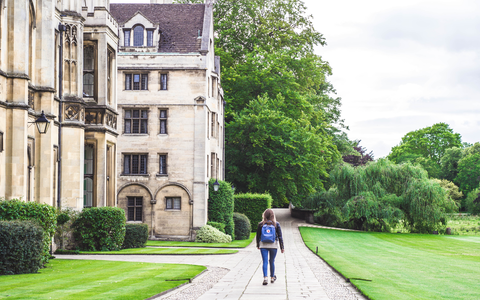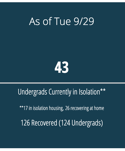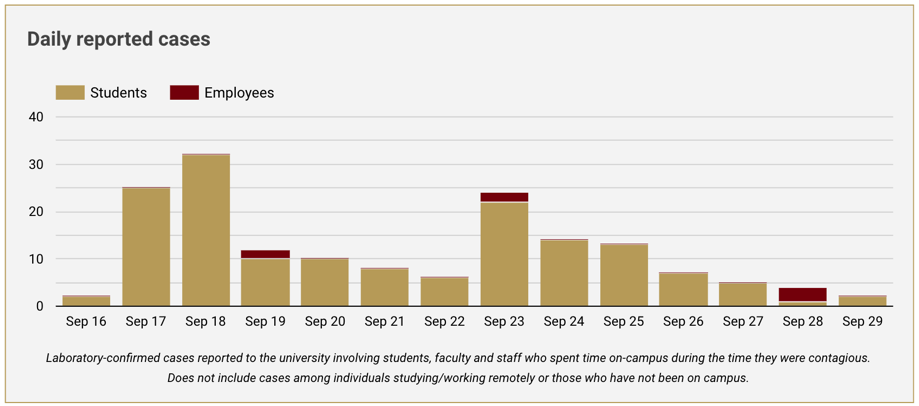 The coronavirus pandemic has impacted nearly every aspect of everyday life – and higher-ed is no exception. Since the spring, school leaders have been reimagining what college will look like, trying to come up with creative solutions for residential life, student activities, admissions events, and of course, educating their students.
The coronavirus pandemic has impacted nearly every aspect of everyday life – and higher-ed is no exception. Since the spring, school leaders have been reimagining what college will look like, trying to come up with creative solutions for residential life, student activities, admissions events, and of course, educating their students.
Best-Laid Plans
Throughout the summer, colleges and universities released their plans for the fall semester. Here’s what the national breakdown looked like as of September 25, 2020.
 Only about 4% of institutions are committing to educating their students fully in person, and many of those are two-year schools. When looking at the breakdown of four-year institutions, private schools are much more likely than public to offer primarily in-person learning. Let’s take a look at what each of these types of plans looks like.
Only about 4% of institutions are committing to educating their students fully in person, and many of those are two-year schools. When looking at the breakdown of four-year institutions, private schools are much more likely than public to offer primarily in-person learning. Let’s take a look at what each of these types of plans looks like.
Fully or Primarily In-Person:
The schools offering in-person learning will look very different this fall. Detailed plans for social distancing measures, pop-up testing centers, and contact tracing have been put in place. Some features present on these campuses include:
- Frequent testing
- One-way walkways throughout campus
- Masks in classrooms, dining halls, and public spaces
- Temperature checks at building entrances
- Quarantine dorms for sick or exposed students
- Cohorts of students using dining facilities at the same scheduled times
- Reduced class sizes
Schools that have been able to maintain their primarily in-person status so far are committed to open and transparent communication. For example, Boston College (above) and Elon University (below) publish their testing outcomes daily. All of the schools offer detailed plans of their guidelines, easily found on their website, like Colby’s Fall 2020 Campus Guide. Other schools that are welcoming students back to campus include Bucknell, Georgia Tech, Tulane, and University of Miami.
Hybrid:
The hybrid or HyFlex learning model offers in-person and online learning concurrently—students can choose whether to participate in-person, online, or a combination of both. Tufts is offering classes in hybrid, virtual and in-person formats and is creating residential cohorts of six to twelve students. The plans vary, but share one characteristic: they all offer choice and flexibility.
In order to safely accommodate students on campus, colleges are making a variety of arrangements. Duke is offering residential housing to first year students and sophomores, while University of Michigan is able to accommodate all students who wish to return to campus.
Fully or Primarily Online:
From the beginning, several schools decided to commit to the fully or primarily online model due to the risk of the spread of Covid-19 on a college campus. Planning ahead of time allowed faculty to receive training and to take advantage of this once-in-a-century challenge to craft their courses for remote learning with an active, student-centered approach. Throughout the month of August, many schools opted for remote learning, with 44% of institutions choosing this mode of instruction. You’ll find many elite schools in this category, including Harvard, Princeton, Yale, and Stanford. University of Pennsylvania joined the fully remote group, pivoting from their hybrid plan in mid-August.
Plans Change
Only a few weeks in, and many colleges that initially welcomed students on campus have been forced to shut down their in-person operations. Dr. Anthony Fauci remarked on the situation, urging universities not to send these students home. On NBC’s Today Show he said, “It’s the worst thing you could do… you could be seeding different places with infection.” So, what options do universities have? Iowa State, a campus with one of the biggest outbreaks, has chosen to keep their students on campus and are still holding small in-person classes. They have increased their number of quarantine beds, expanded testing centers and contact tracing, and school leaders feel confident that “exposure is not happening in classrooms and laboratories where mitigation strategies are in place.”
Northwestern University, which isn’t scheduled to start classes until later this month, originally planned to have all students back on campus. However, on August 28th, they announced a last-minute shift to only allow juniors and seniors to return in person due to their limited capacity of quarantine beds, which they estimated would be filled within 7-10 days of move-in. Then, the school would be left with no choice other than to send students home, in direct opposition with Dr. Fauci’s advice. The Chicago Tribune reported that the decision came nine days before move-in.
After an increase in confirmed cases on campus, SUNY Oneonta announced on September 3rd that they would be ending residential housing for this semester. Students who are in quarantine or isolation are remaining there until they are cleared by the Department of Health, but all other on-campus students are moving out in the three days following the announcement.
Sudden announcements and shifts to remote learning, like those made by Northwestern, Oneonta, UNC Chapel Hill and Colorado College, leave students and families feeling unsettled and even angry with the school leaders. However, it’s important to remember the goal of all involved: mitigate the risk for the community.
What Now?
Be patient and keep in mind that college is an important part of your career and life path, and that eventually you will be able to return safely. Keep an open mind and try to embrace the challenges as they arise.
At Collegiate Gateway, we understand the stress and anxiety surrounding these new changes in the college process. Explore our upcoming presentations on our website or set up a complimentary consultation to learn about our admissions consulting services. Whatever your question, Collegiate Gateway is happy to help!



